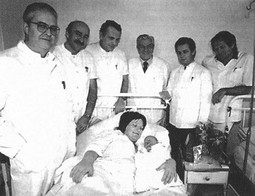MINISTER OF HEALTH and Social Welfare Darko MilinovicLess than ten days since Prime Minister Ivo Sanader resigned as both Prime Minister and the president of the HDZ the conservative right wing of the party has been quick to pander to the Church. Over the past few months Sanader had cooled relations with the top Church establishment, something the party's right wing evidently objected to. This time the HDZ has begun to accommodate the Church by way of Parliament, where Andrija Hebrang has started pulling all the strings just days ago. At the end of last week there was a heated debate in Parliament on proposed legislation on medically assisted fertilisation. The debate became heated because of some conservative positions in the proposed legislation that are in line with the Church's backward notions. The existing legislation on medically assisted fertilisation in Croatia was adopted back in 1978 and is entirely obsolete, and given that it touches an exceptionally sensitive area of human life experts have proposed four different preliminary drafts of new legislation over the past fifteen years, non of which managed to make their way to Parliament. With the departure of Ivo Sanader the circumstances have changed dramatically. Now, Darko Milinovic, the new vice president of the HDZ and the healthcare minister, is proposing legislation that forbids the freezing of embryos, which is in line with the Church's position that embryos are destroys by freezing. This harmony in the positions of the Church and the HDZ can also be understood as the party's desire to patch things up with the Church establishment. Their relation may start mending if this controversial legislation is passed, but that was temporarily put off when the opposition quit the session. Milanka Opacic even coined a new slogan for the proposed law, "When the heart says: child, Government says: no." The Roda association organised soap bubble blowing on Ban Jelacic Square to evoke the burst dreams of unwed couples that the new law would not allow artificial fertilisation to.
But, in spite of all the opposition to it, when all of the HDZ deputies gather in Parliament, which was not the case at the last vote, the opposition will find it difficult to delay with the adoption of the legislation, which was to have been passed quietly and under urgent procedure, without public debate. And while Croatia very much needs this legislation, judging by the reactions to date and the experience of other countries, especially those of Italy, some of its provisions will probably find themselves tested before the Constitutional Court, like those that give the right to artificial fertilisation only to married couples. If the Constitutional Court revokes this and perhaps some other provisions of the law, the question that will arise will be whether Parliament is even capable of adopting legislation that is not unconstitutional.
And while in 1983 Croatia earned fame as the eighth country in the world in which in vitro fertilisation was successful, it is today one of the few countries in the world that lacks modern legislation on medical fertilisation. And although unwed couples are equal before the law with married couples, the new legislation could leave over two thousand couples, the estimated number of unwed couples with fertility problems, without the right to descendants. This figure does not include women who do not have partners and wish to have a child. Besides the ethical issue of whether a physician should be able to ask to see a patient's marriage certificate, the profession will also face a greater predicament - will unwed couples even be allowed to come in for any tests, treatments, interventions or any other kind of medical treatment and to what level can they be treated? But even married couples will not sleep easy if this law comes into force. A provision that only three egg cells can be fertilised at a time will increase the number of attempts at fertilisation that women will require, especially those over 40 years of age, because the new legislation will reduce the already limited chances of a successful pregnancy. The chances of success in one in vitro fertilisation procedure with young women is from 30 to 40 percent, while for women above 40 the chances are about eight percent and drop even more with greater age. In the current typical procedure with eight cells in the fertilisation procedure, five embryos were produced on average, as every cell cannot be successful fertilised. Two or three of these five embryos are used and the rest frozen, to be used again if the woman does not achieve a pregnancy or wishes to have a second child. A combination of fresh embryo transfer and the transfer of frozen embryos yields a 45 percent success rate.
NECESSARY LEGISLATION For years Dr. Velimir Simunic sat on the commissions that drafted proposed legislation on medical fertilisation, although not on the latest such body, but points out that it would be good for the proposal to be passed into law, even if it is subsequently amendedThe new legislation, however, evidently follows the Church's line that the embryo is the start of a new life, which is not in dispute, and forbids the freezing of embryos. It allows, instead, the freezing of egg cells, which is technically more complicated and financially much more demanding. But the biggest problem is that this even further reduces the chances for a successful conception. First of all, namely, three cells have to be picked out of a group of eight, which is not easy because it is hard to judge which are of the highest quality. And as fertilisation does not have a one hundred percent success rate, less than two embryos will, as a rule, be produced from these three cells. The transfer of one or, rarely, two embryos into the womb will lead to an approximately 20 percent chance of pregnancy, while the current procedure yields an about 35 percent chance of success. That means that the new method will be from 10 to 15 percent less successful than the old one and that that many fewer children will be born, which is certainly not good in a country in which 10 thousand people more die each year than are born.
The biggest problem is in interpreting what happens to the embryo when it is frozen. It appears that the Church, and Croatian Government, are of the opinion that the embryo is destroyed be freezing. But experts say that this is not the case. Frozen embryos can be kept for years, and increase the chances of a pregnancy in combination with fresh embryos. Besides, the number of embryos that can be produced by artificial fertilisation is very limited and each one is precious. But if one was to compare the reproductive loss in nature, the number of lost egg cells and embryos is much greater than in artificial fertilisation. If Croatia knew how to learn from the mistakes of others, it would know that the shortcomings of this solution have already been demonstrated in Italy and in Germany, practically the only ones to adopt similar legislation. The provisions of the Italian law pertaining to how many egg cells can be fertilised are currently before the Italian constitutional court. Even very Catholic countries like Spain and Poland have much more liberal laws, which provide for better treatment of infertility in line with the latest insight. Besides Great Britain, France and the USA, these include Slovenia, the Czech Republic, Poland, and Hungary, even Russia. But the Church evidently has its own experts, who say in debate that more use should be made of the Billings and Napro methods and that these methods have a success rate as high as 50 percent. What they clearly failed to mention is that all of these methods are used, but that there are couples whom this does not help and who then turn to assisted fertilisation methods, i.e. in vitro fertilisation. Methods of in vitro fertilisation are used only when all other simpler methods did not yield results.
SDP SECRETARY Igor Dragovan has a child conceived by artificial fertilisationBut that the Church does not always have the sanest views is demonstrated by the cases of some priests who refuse to baptise a child conceived by artificial fertilisation. And while the official Church does not support this, because the child should not be held responsible for the errors of the parents, the Church's teachings do say that the "right to a child does not exist, because a child is always a gift from God." And there is yet another aggravating circumstance that the future parents of children conceived by in vitro fertilisation will have to face if the new legislation comes into force. It foresees, namely, that a child conceived with donated egg cells will at the age of 18 have the right to find out who their biological parents are. Experience in Scandinavian countries and Australia, which have adopted similar legislation, has shown that there was a significant reduction of the number of sperm and egg cell donations. And while experts point out that this child has no property rights or claims on the person that provided their genetic material, even someone's most noble motives could falter in the fear of the possibility that, 18 years later, some young man or woman could knock on their door and nevertheless seek a part of their property. This, on the other hand, equates the donation of sperm and egg cells with the procedure for adopted children, who also have the right to find out who their biological parents are. How then would the issue of surrogate mothers be resolved in Croatia, an ever more frequent phenomenon in the USA?
But those who say that the proposed legislation is shoddy through and through are in the wrong. Experts point out as its positive points those provision that stipulate better control mechanisms, the introduction of a central registry and a bioethical commission that will monitor and resolve complex situations and the issue of licenses to physicians. Some feel that it is a good thing that the new legislation will allow women to have more free attempts and that this is not limited by her age. But some in the field feel that this provision, besides making treatment more expensive, could even encourage women to have even later pregnancies, i.e. opt for methods of assisted fertilisation. Besides the fact that the chances of a natural conception are greater in younger women, they also have greater chances of successful in vitro fertilisation. Older women require more attempts, and there are greater risks to both her and the child. The problem of fertility among Croatia women is very significant. They have their first child on the average at the age of 29, and give birth to about 1.31 children in their reproductive phase. Not even two. Over the past ten years the number of women who have their first child after the age of 32 has doubled. That is why treating infertility is a significant demographic contribution, especially if one takes into consideration that over the past 25 years almost 20 thousand children, or about 2 percent of all those born in Croatia, were conceived through various methods of assisted fertilisation. And besides the fact that the new legislation will likely reduce the number of children born by assisted fertilisation, it will also make the entire procedure more expensive, and one test tube baby will, colloquially put, be at least twice as expensive. The current cost of just one attempt at artificial fertilisation is about 20 thousand kuna.
CROATIA'S FIRST TEST TUBE BABY In 1983 the team from Petrova Hospital was the eighth in the world to successfully carry out the in vitro fertilisation of the baby Robert VerigaIs it truly possible that, in the 21st century, couples in Croatia will visit their physician with a marriage certificate in hand? And what is the next step - will only couples married in a Catholic church be allowed artificial fertilisation, while Muslims and Jews will be forbidden entry? Will those suffering from AIDS only be able to get treatment if they can prove that they are not homosexuals? Will underage girls be accepted to maternity wards only if they have a husband? Will, perhaps, abortions only be allowed to women who are not married? Will the Church also pen a "law on prescription glasses"? By its good old tradition the Church, and thereby the Croatian Government that obediently follows it, does not solve problems where they arise, but rather turns public opinion even more against itself. And nobody wonders how many naturally conceived children there are in Croatia whose parents are divorced or who are abused. It would be a good idea to have the law also forbid divorces and adultery, since it is ineffective in protecting children from abuse.
Croatian pioneer of in vitro fertilisation
Dr. Velimir Simunic is the chairman of the Institute for Human Reproduction at the Clinic for Gynaecological Disorders and Obstetrics at Petrova Hospital, the president of the Croatian Society for Human Reproduction and the leader of the team that in 1983 succeeded in the first in vitro fertilisation in Croatia.
NACIONAL: Are you happy with the fact that the new law on medically assisted fertilisation, on which the public and the expert community have a number of objections, was not voted through last week? - As the president of the Croatian Society for Human Reproduction I have to say that I am sorry that the law was not passed. Even though I feel that the law needs some corrections, for us as the expert community it is better to have any kind of law than no law at all. So far we have been in a kind of legal vacuum, since the old law from 1978 only covered the donation of sperm. And I am firmly convinced and expect those provisions that prove to be overly restrictive and ill considered to be corrected sooner or later. I have for many years sat on the commissions that drafted this legislation, except for the latest such commission, and I know what a tough job it was. All former ministers and governments abandoned a final draft of this legislation for one reason or another, which may be clear and may not be, but the fact is that Croatia was nowhere close to adopting a new law. In that respect I certainly congratulate the Minister, Dr. Milinovic, who has relatively quickly, in spite of the well-known objections to it, sent the draft legislation into Parliament and for having a firm will to see it passed into law. It is clear that the legislation was drafted under various influences, and that the professional community was only sometimes consulted, which was demonstrated by last week's bitter debate in Parliament. All Croatian reproductive medicine experts, including myself, feel that the freezing of egg cells is more complex, more expensive and less successful than the freezing of embryos. And the fertilisation of only three egg cells will reduce the success rate and the number of pregnancies. I fear that the donation of reproductive cells will, as a result of some of the provisions, be only sporadic and within the family.
NACIONAL: As a doctor will you, if this proposal is passed into law, ask your patients to show you a marriage certificate? - Some form of control will have to be introduced. The entire expert community will have to adopt some directives. Neither I or my associates, or the patients we see, will be in a position to ignore the law. And it is clear that, besides the doubts and public debate, this kind of legislation will lead a significant number of couples to seek medical treatment abroad. Even now for various other reasons about 500 to 700 couples are receiving treatment in countries like Slovenia, the Czech Republic, Slovakia, Hungary, Poland and Ukraine, which have much more liberal legislation. It is certain that nothing can stop a woman in her desire for motherhood and reproduction. This was demonstrated in Italy where there have been charter flights and organised trips for years for precisely these countries, where artificial fertilisation is perhaps done at a much lower standard, but they have no other choice. Besides, Italian women also come to us.








